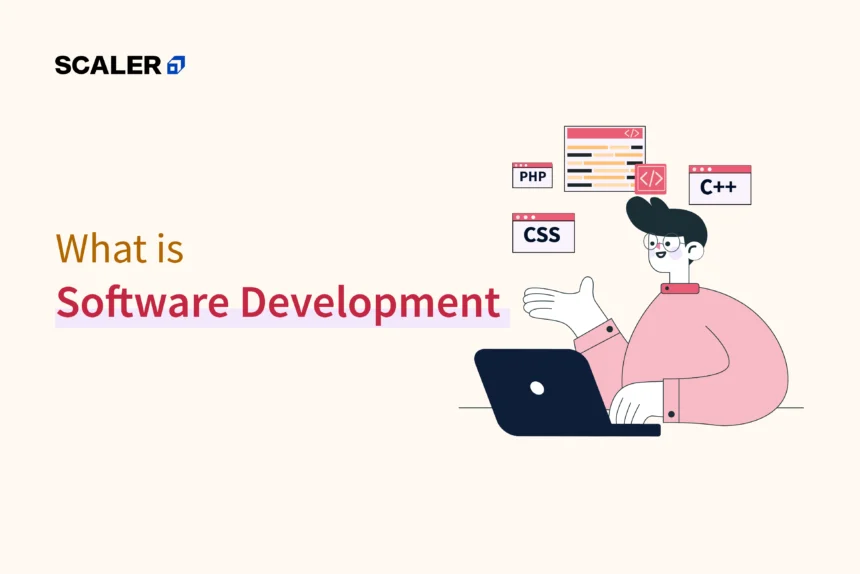Software development is the lifeblood of the digital age. It’s how we design, build, and maintain the software that powers everything from our smartphones to the complex systems running global businesses. The impact of software development is undeniable:
Explosive Growth: The global software market is poised to eclipse $600 billion by 2023 according to the Gartner report on the global software market. This highlights the vast reach and importance of software in our lives.
High Demand, High Reward: Software developers are in high demand, with the U.S. Bureau of Labor Statistics projecting a growth rate of 22% by 2030 – much faster than the average for all occupations.
In this guide, we’ll delve into the world of software development, exploring its significance, the essential skills involved, and how you can launch your career in this dynamic field.
Ready to dive into the world of software development?
Discover Scaler’s Software Development course today and equip yourself with the skills needed to thrive in this rapidly growing industry. Enroll now and take the first step towards a rewarding career in software development!
What is Software Development?
Software development is the process of designing, writing (coding), testing, debugging, and maintaining the source code of computer programs. Picture it like this:
Software developers are the architects, builders, quality control, and renovation crew all in one! They turn ideas into the functional software that shapes our digital experiences.
This covers a lot of ground, from the websites and tools you use online, to the apps on your mobile devices, regular computer programs, big systems for running companies, and even the fun games you play.
Steps in the Software Development Process
Building software isn’t a haphazard process. It generally follows a structured lifecycle known as the Software Development Life Cycle (SDLC). Here’s an overview of its key phases:
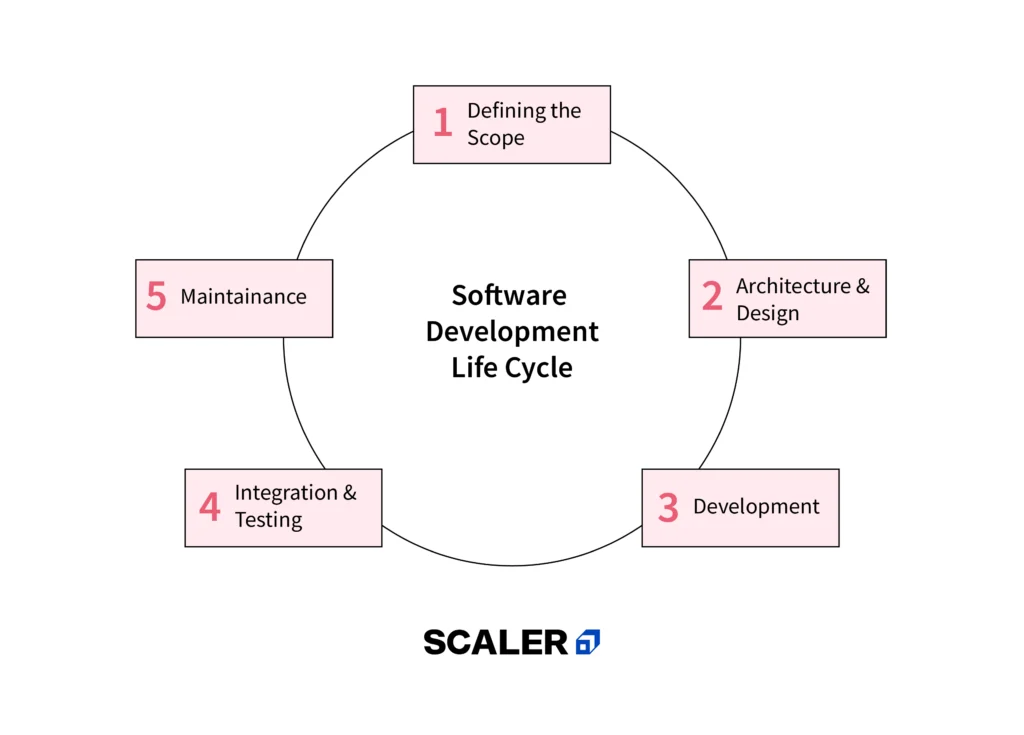
1. Needs Identification
At this early stage, it’s all about figuring out the “why” of the software. What’s the issue you’re trying to solve for users? Will it simplify a business process? Will it create an exciting new entertainment experience? Or will it fill an existing market gap? For instance, an online retailer might recognize that their website’s recommendation engine needs to be improved in order to increase sales.
2. Requirement Analysis
Once the purpose is clear, the team delves into the detailed blueprint. They meticulously gather all the specific requirements the software must fulfill. This includes defining features, how users will interact with the software, security considerations, and necessary performance levels. Continuing our example, the e-commerce company might determine requirements for personalized product suggestions, integration with their inventory system, and the ability to handle a high volume of users.
3. Design
In this phase, software architects and designers create a structural plan. They’ll choose the right technologies (programming languages, frameworks), decide how the software is broken into modules, and define how different components will interact. For the recommendation engine, designers might opt for a cloud-based solution for scalability and use a machine learning library to power the suggestion algorithm.
4. Development and Implementation
This is where the building happens! Developers use their programming expertise to bring the design to life, writing the code that embodies the application’s logic and functionality. Depending on the project’s complexity, multiple programming languages and tools might be involved. In our recommendation engine example, the team could utilize Python for the machine learning algorithm and a web framework like Flask to integrate it into their website.
5. Testing
A rigorous testing phase is crucial to ensure the software is bug-free and functions as intended. Testers employ techniques like unit testing (checking individual code components), integration testing (how everything works together), and user acceptance testing (getting real-world feedback). In our scenario, testers will verify that the recommendation system suggests relevant products and gracefully handles different scenarios, such as when users have limited browsing history.
6. Deployment and Maintenance
It’s launch time! The software is deployed to its final environment, whether that’s release on an App Store, a live web application, or installation on company systems. However, the journey doesn’t end here. Continuous maintenance and updates are vital for security patches, addressing bugs, and adding new features down the line.
Key Note
The SDLC can have different models (like Waterfall, and Agile). Real-world development often involves iterations and revisiting these stages.
Types of Software
The world of software is divided into broad categories, each serving a distinct purpose. Let’s explore these main types:
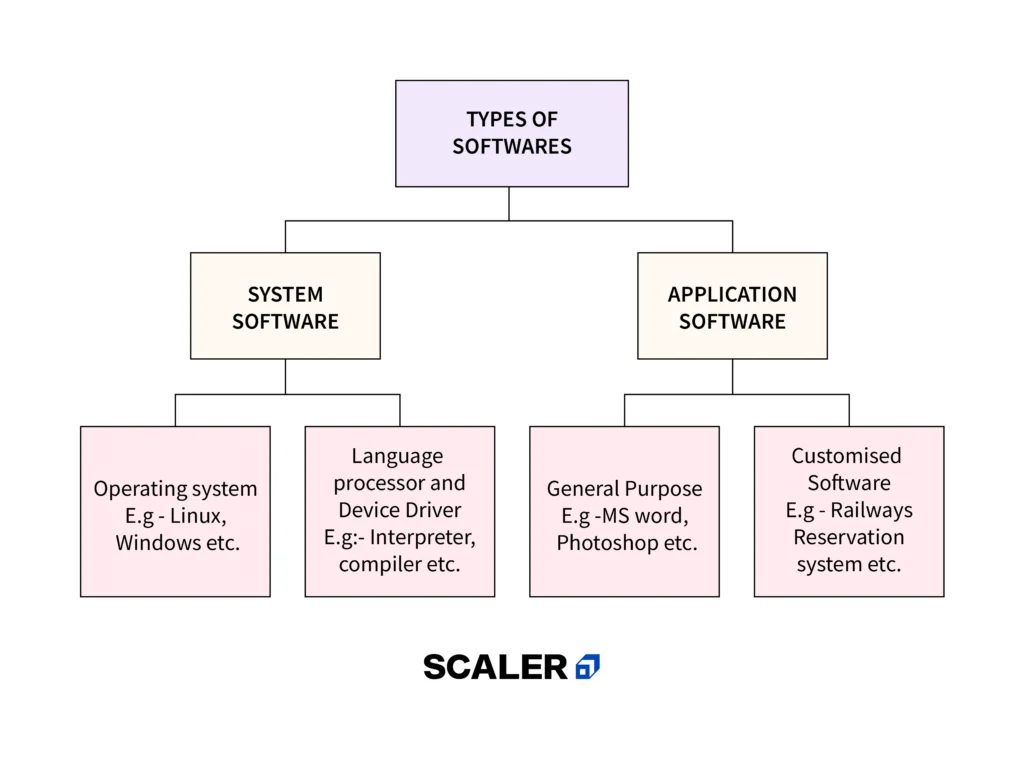
1. System Software
Think of system software as the foundation upon which your computer operates. It includes the operating system (like Windows, macOS, or Linux), which manages your computer’s hardware, provides a user interface, and enables you to run applications. Additionally, system software encompasses device drivers, the programs that allow your computer to communicate with devices like printers and webcams, and essential utilities like antivirus software and disk management tools.
2. Application Software
Application software is what you interact with directly to get things done, whether for work or play. This encompasses the programs you’re familiar with, such as web browsers (Chrome, Firefox), productivity suites (Microsoft Office, Google Workspace), video and photo editing software (Adobe Premiere Pro, Photoshop), games, and music streaming services like Spotify.
3. Programming Languages
Software coders use programming languages to create instructions. Programming languages also create application software and system software. Python, C++, Java, and C# are among the best known programming languages. Python is flexible and easy to learn for beginners, while Java is used in Android apps and enterprise programs. JavaScript makes websites interactive, while C++ is used for high-performance games and systems-level software development.
Important Note
While these categories are helpful, the lines between them can sometimes blur. For example, a web browser, though considered application software, heavily relies on components of your system software to function properly.
Why is Software Development Important?
Software development isn’t just about coding; it’s the engine driving progress in our modern world. Here’s why it matters:
The Fuel of Innovation: Breakthrough technologies like artificial intelligence, self-driving cars, and virtual reality would be impossible without sophisticated software. Software development pushes the boundaries of what’s possible, enabling entirely new industries and ways of interacting with the world.
Streamlining and Automating: From online banking to automated customer service chatbots, software makes processes faster, more convenient, and less prone to human error. This increased efficiency revolutionizes businesses and saves countless hours across various domains.
Adapting to Change: In our rapidly evolving world, software’s ability to be updated and modified is crucial. Whether it’s adapting to new regulations, customer needs, or technology trends, software empowers organizations to stay agile and remain competitive.
Global Reach: The internet and software transcend borders. Software-powered platforms connect people worldwide, facilitating remote work, global collaboration, and the rise of e-commerce, opening up markets once limited by geography.
Software Development’s Impact Across Industries
Let’s consider a few examples of how software changes the game in various sectors:
- Healthcare: Software powers medical imaging tools, analyzes vast datasets to discover new treatments and even assists with robot-guided surgery, ultimately improving patient care.
- Finance: Secure banking platforms, algorithmic trading, and fraud-detection software enable the flow of money while reducing risk.
- Education: Online learning platforms, interactive simulations, and adaptive learning tools make education more accessible and personalized for students of all ages.
- Transportation: Ride-hailing apps, traffic management systems, and developments in self-driving technology all rely on complex software systems.
Key Features of Software Development
Building high-quality software that meets user needs and endures over time requires a focus on these essential features:
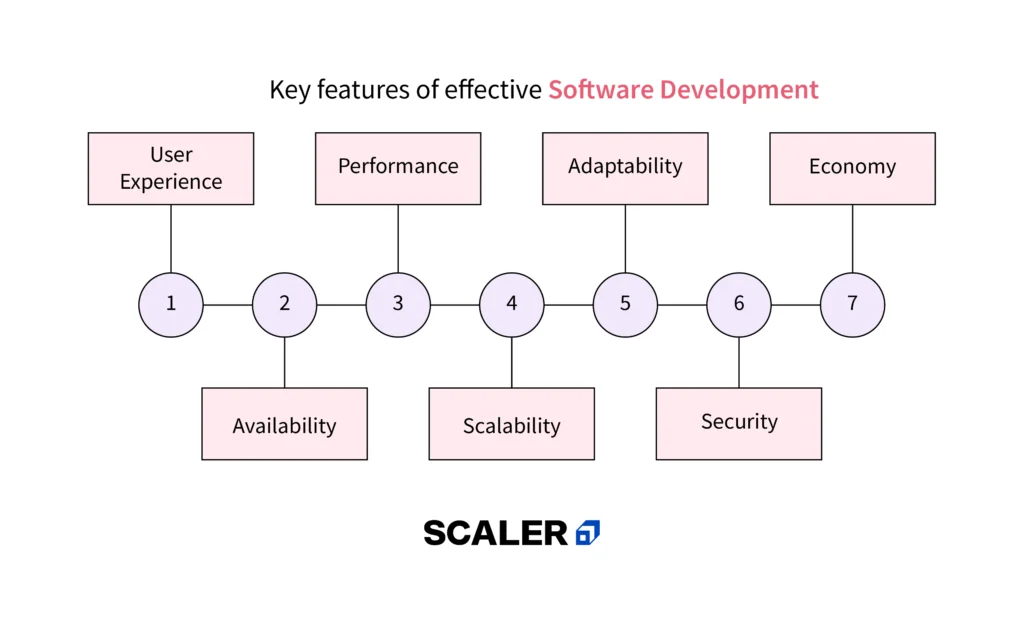
Scalability: The ability of software to handle an increasing workload. Imagine a social media app: good software needs to work effortlessly whether it’s serving a few thousand users or millions. Scalability involves planning for growth and ensuring the system can expand gracefully.
Reliability: Users expect software to work consistently and as intended. Reliability encompasses thorough testing to minimize bugs and crashes, as well as implementing error-handling procedures to provide the best possible experience even when unexpected glitches occur.
Security: With cyberattacks on the rise, protecting user data and preventing unauthorized access is paramount. Secure software development includes careful encryption practices, safeguarding against common vulnerabilities, and constantly staying updated to address potential threats.
Flexibility: User needs change, technologies evolve, and new features are often desired. Flexible software is designed to be adaptable and maintainable. This makes it easier to introduce updates, integrate with other systems, and pivot in response to market changes.
Explore Scaler’s Software Development course today and gain the skills to build scalable, reliable, secure, and flexible software solutions. Enroll now and start shaping the future of digital innovation!
Software Development Methodologies
Think of software development methodologies as different roadmaps to guide a software project from start to finish. Let’s explore some popular approaches:
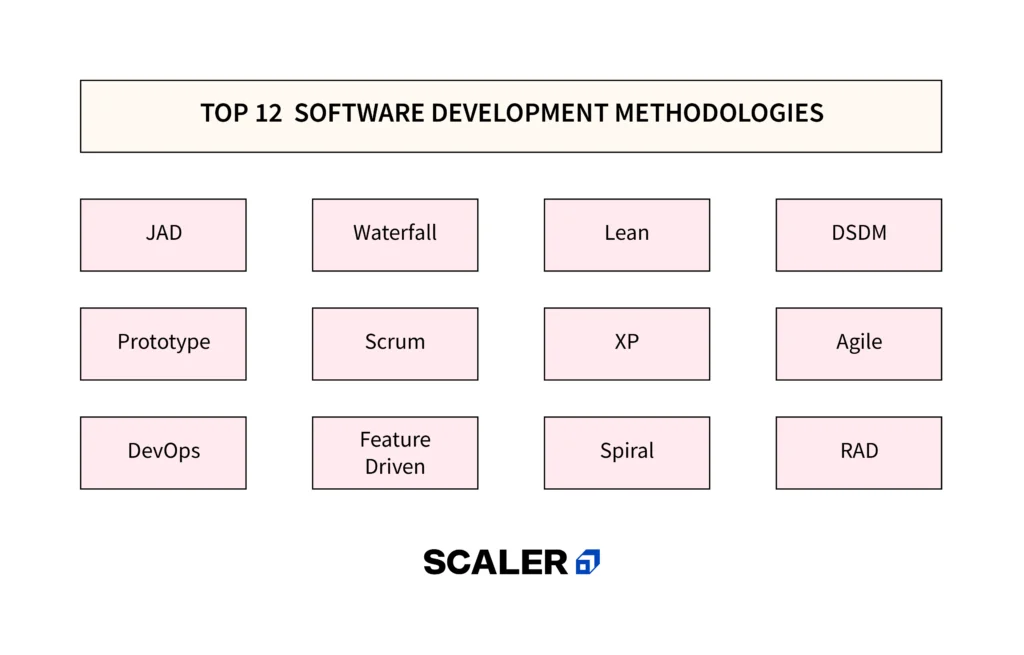
Waterfall: The Traditional Approach
The Waterfall model is linear and sequential. It involves phases like requirements analysis, design, coding, testing, and then deployment. Each phase must be fully complete before moving on to the next. This approach is best suited for projects with very clear, unchanging requirements and a long development timeline.
Agile: Embracing Iteration
Agile methods like Scrum and Kanban focus on short development cycles (sprints), continuous feedback, and adaptability to change. They emphasize collaboration between developers, stakeholders, and end-users. Agile methodologies are well-suited for projects where requirements might shift or evolve, and where delivering working software quickly is a priority.
DevOps: Bridging Development and Operations
DevOps focuses on collaboration between development teams and IT operations. It emphasizes automation, frequent updates, and monitoring to enable continuous delivery and rapid issue resolution. The aim is to ensure faster releases with increased stability. This benefits businesses by allowing them to innovate quickly, delivering updates and features at a much faster pace while maintaining reliability.
Choosing the Right Methodology
The best methodology depends on factors like the project’s size and complexity, the clarity of requirements upfront, company culture, and the desired speed of delivery.
Modern Trends: Hybrid Approaches and Adaptability
Many organizations adopt variations or hybrid approaches, combining elements of different methodologies to suit their specific needs. The ability to adapt the process itself is becoming a key hallmark of successful software development.
Software Development Tools and Solutions
Building software involves a whole toolkit beyond just coding skills. Let’s take a look at some commonly used categories of tools and technologies:
Integrated Development Environments (IDEs)
Think of IDEs as the developer’s powerhouse workspace. They combine a code editor, debugger, and compiler/interpreter, providing a streamlined experience. Popular IDEs include Visual Studio Code, IntelliJ IDEA, PyCharm, and Eclipse. IDEs boost productivity with features like code completion, syntax highlighting, and error checking, simplifying the overall development process.
Version Control Systems (e.g., Git)
Version control systems act like time travel for your code. Git, the most widely used system, allows developers to track every change made, revert to older versions if needed, collaborate effectively, and maintain different branches of code for experimentation. This provides a safety net, facilitates easy collaboration, and streamlines code management.
Project Management Tools (e.g., Jira, Trello)
These tools help organize tasks, set deadlines, and visualize the project’s progress. They often integrate with methodologies like Agile (Jira is particularly popular for this) and provide features like Kanban boards or Gantt charts to keep projects organized and efficient, especially within teams.
Collaboration Platforms (e.g., Slack, Microsoft Teams)
These platforms serve as a communication hub for development teams. They enable real-time messaging, file sharing, and video conferencing for seamless collaboration, reducing email overload and promoting quick problem-solving and knowledge sharing among team members.
Other Important Tools
- Cloud Computing Platforms (AWS, Azure, Google Cloud): Provide on-demand access to computing resources, databases, and a vast array of development tools.
- Testing Frameworks: Tools that help design and execute automated tests to ensure software quality.
- Web Frameworks (Django, Flask, Ruby on Rails): Offer structure and reusable components for building web applications.
Jobs That Use Software Development
- Quality Assurance (QA) Engineer: These professionals meticulously test software to identify bugs and ensure quality before release. They employ both manual and automated testing methods, working closely with developers to enhance the final product.
- Computer Programmer: Computer Programmers focus on the core act of writing code. They use specific programming languages to translate software designs into functional programs.
- Database Administrator (DBA): DBAs are responsible for the design, implementation, security, and performance optimization of database systems. They manage the storage, organization, and retrieval of an organization’s crucial data.
- Senior Systems Analyst: Systems Analysts act as a bridge between business needs and technical solutions. They analyze an organization’s requirements, propose software solutions, and often oversee the development process to ensure the system meets its intended goals.
- Software Engineer: This is a broad term encompassing roles involved in designing, building, testing, and maintaining software applications. Software Engineers might specialize in areas like web development, mobile development, game development, or embedded systems.
Software Development Resources
Online Courses and Platforms
- Beginner-friendly: Look for websites that have interactive lessons and guided projects to start with.
- Comprehensive Programs: Look for websites that cover a vast array of languages, frameworks, and specializations.
- Scaler’s Full-Stack Developer Course: A structured program with industry-relevant curriculum, experienced mentors, and strong community support.
Tutorials and Documentation
- Official Sources: Programming language websites (e.g., Python.org) and framework documentation provide the most reliable information.
- Community Hubs: Websites like Stack Overflow are phenomenal for troubleshooting and finding answers to common questions.
Coding Communities
- Online Forums: Engage with fellow learners, seek help, and discuss projects on platforms like Reddit (programming-related subreddits) or Discord servers dedicated to software development.
- Meetups: Network with developers in your area through local meetups and events.
How Scaler Can Help?
Scaler’s Comprehensive Software Development Course can be an accelerator on your software development journey. Consider the advantages:
- Structured Learning: A well-designed curriculum takes you systematically from core concepts to advanced applications, offering a clear path forward.
- Mentorship: Guidance from industry experts provides valuable insights and helps you overcome roadblocks.
- Projects and Practical Experience: Hands-on building solidifies learning and creates a portfolio to showcase your skills.
- Community and Career Support: Interaction with peers and access to career services can be beneficial as you navigate the journey into software development.
Important Note
Learning software development is an ongoing process. Even experienced developers continue to explore new technologies and techniques.
Conclusion
- From ubiquitous applications to world-changing inventions that fuel global digitalization efforts in every sector, it is the software development that does all the creating.
- Designing, developing, testing and deploying are among the critical stages of the SDLC (Software Development Life Cycle).
- High-quality software should be scalable, safe and reliable. It must also perform well with good user experience while being easy to understand for other developers.
- With roles ranging from quality assurance engineers to software engineering engineers there are many opportunities available in different industries when it comes to software development.
- Continuous learning and community support are necessary for both beginners and experienced developers because of ever-evolving technologies which help them stay current within this domain of expertise or advance their careers further.
FAQs
What is meant by a software developer?
A software developer is like an architect and construction crew combined. They design and build the software that powers everything from websites to complex enterprise systems.
What is the full form of SDLC?
SDLC stands for Software Development Life Cycle. It refers to the structured process of creating software, from defining requirements to deployment and maintenance.
Is software development the same as coding?
Coding (writing code) is a major part of software development, but it also involves problem-solving, design, testing, and collaboration.
What does a software developer do?
Software developers design, write code, test, debug, and maintain software applications. Their specific tasks depend on the project and their area of specialization.
What are some software development projects?
Software development projects can range from simple websites or mobile apps to complex enterprise systems, games, and even software for self-driving cars. The possibilities are endless!
